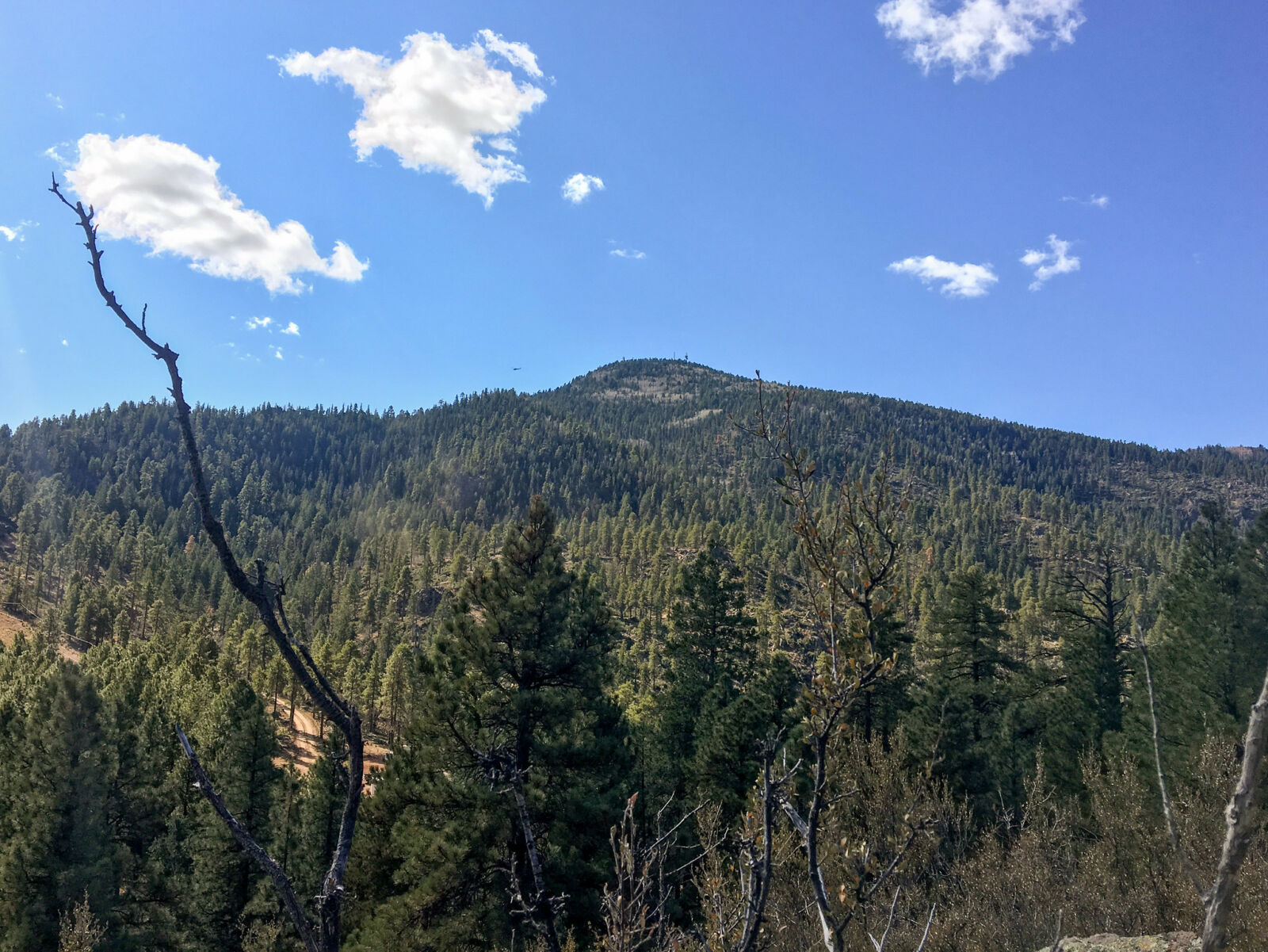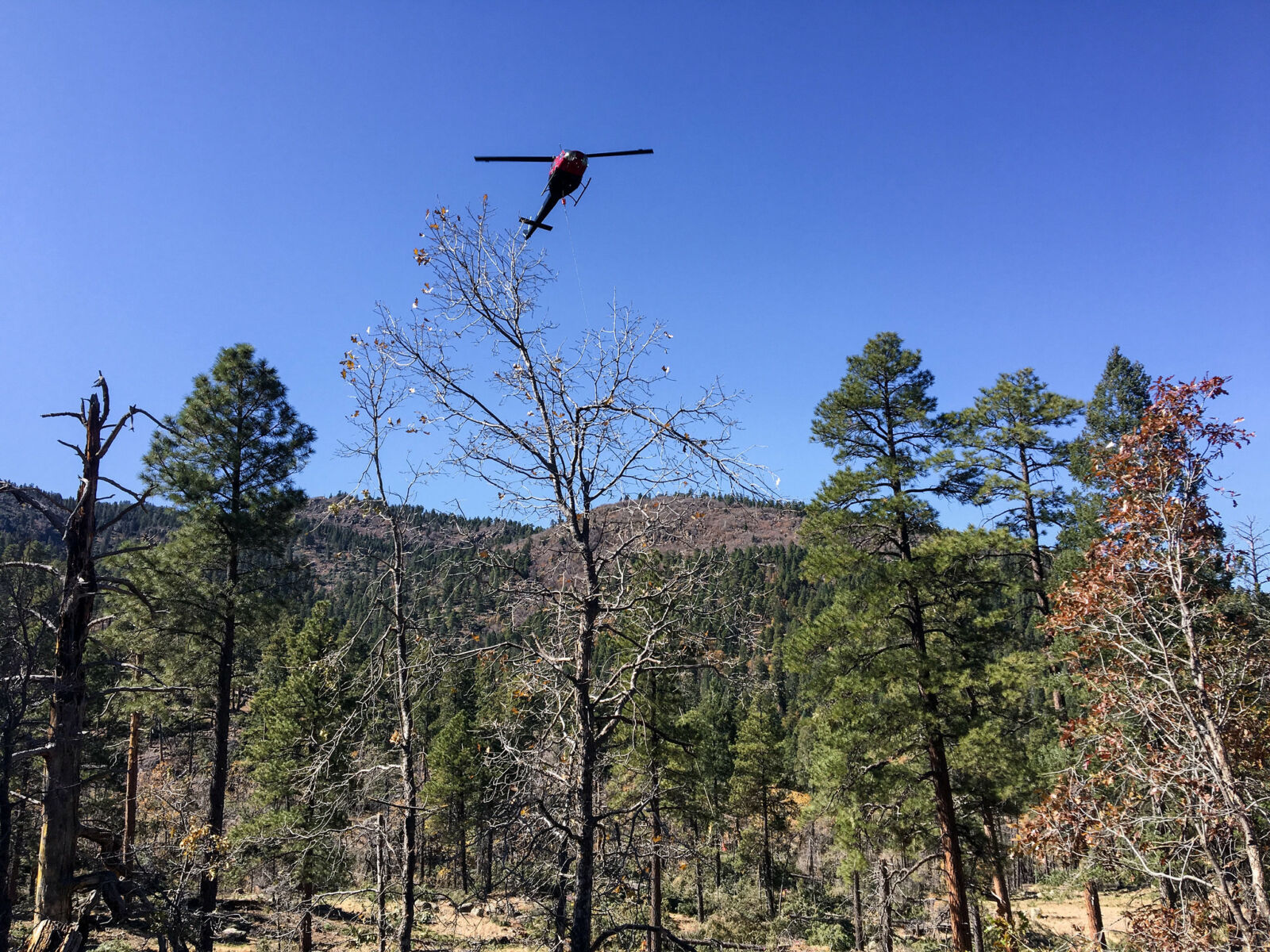Situated adjacent to the City of Williams is a mountain of great importance to local citizens, private entities, municipalities, jurisdictions and tribes that help steward its well-being. It is known as Bill Williams Mountain, and it is an iconic feature of the northern Arizona landscape.
The Kaibab National Forest, in partnership with Coconino County, the National Forest Foundation, and the Arizona Department of Forestry and Fire Management, began technical steep slope forest restoration and fuels reduction work on the mountain in September 2019. This project is a top priority for all of the partners in order to reduce unnaturally dense timber stands and heavy accumulations of dead and down woody fuels on the highest portion of the mountain’s north face in areas difficult to access.
The partners’ mutual goal is to reduce risks to life and property and protect critical watershed drainages that deliver the vital water supply to the City of Williams as well as to many other communities to the south. This effort will also reduce the risk of a potentially destructive wildfire and the probability of post-wildfire flooding that would likely have devastating effects on the mountain’s natural resources and on essential infrastructure and neighborhoods in the community below.

The collaboration between the dedicated partners was developed to implement the first stages of strategic planning and to secure resources to begin the complex steep slope restoration treatments on the mountain.
"The Arizona Department of Forestry and Fire Management is proud to partner with Coconino County, the National Forest Foundation, the Forest Service and the other partners in the Bill Williams Mountain Restoration Project. This project is critical for the protection of natural resources, personal property, and economic values at risk in northern Arizona. This is exactly the type of partnership that we should all pursue as we work together to restore Arizona's forests."
Bill Williams Mountain is located south and uphill from the City of Williams’ cultural, tourist, residential, business and governmental core. It is heavily used for outdoor recreation, residential housing and summer camps as well as hosting a ski area. There have been no significant fire occurrences on the steepest slopes on the mountain for more than a century, which has led to overgrowth and an abundance of dead trees building up in the sensitive drainages above the city.
Severe wildfire and post-wildfire flooding in the area would threaten lives, property and important community and forest resources. It would also result in exorbitant costs to communities and local governments in both the short and longer terms. In addition to immediate expenses including fire suppression, evacuation, and post-fire rehabilitation and repair, long-term impacts could include damage to or complete loss of homes, businesses, and highway, railroad and utility infrastructure, as well as significantly reduced tourism and sales tax revenue.
“The benefit of this restoration work includes improved forest and watershed health, protected communities and water supplies, and broad-reaching habitat improvements,” said Spencer Plumb, conservation finance program manager for the National Forest Foundation. “We see this project as delivering a lot of good for a lot people across multiple uses.”
Steep slope material removal requires highly technical operations with specialty equipment that is not commonly used nor easily accessible in the Southwest. The contract for the first 300 acres of treatment was awarded to Markit! Forestry Management of Colorado Springs. Due to the difficulty of using traditional ground hauling methods on the steep terrain, a helicopter was used to remove material from the cut acres until winter weather temporarily postponed operations in December. The critical work will continue this fall.
“We are very excited to be implementing treatment in the first unit of the steep slope area. Our ongoing collaborative partnerships as well as the unwavering commitment of our employees and stakeholders have been the keys to our success in achieving meaningful results in the treatment of the mountain.”
To date, all 300 acres of the first phase of steep slope treatments have been cut, and material from about 100 acres has been transported off the mountain. Besides the recent steep slope work, the Kaibab National Forest has also been implementing other forest restoration and fuels reduction efforts in the area to include preparing 3,500 acres that are currently offered in timber sales; treating more than 700 acres using hand thinning operations on the steep slopes of the mountain’s south side; and, treating 200 acres using mechanical thinning south of the mountain in an area critical to the success of any future wildfire suppression efforts. Steep slope fuels reduction work will be implemented in phases and will be ongoing over the next several years. More than 1,200 acres are already scheduled for treatments near the top of the mountain as part of this multi-year project.
Officials from Coconino County have identified wildfire and the potential for devastating post-wildfire flooding as a critical health and safety threat to the citizens of the county. A 2017 study conducted by J.E. Fuller Hydrology and Geomorphology at the direction of the Coconino County Flood Control District recommended the development of a pre-disaster plan to identify ways to reduce the impacts of these threats. The county funded the development of a pre-disaster plan and is working with the City of Williams to implement that plan and to seek opportunities to work together and with other partners to improve public safety for the entire community.

“The county and our partners are dedicated to keeping our communities safe,” said Matt Ryan, Coconino County District 3 supervisor. “We know that healthy forests will be less susceptible to catastrophic wildfire and post-wildfire flooding, and are we are proud of the work we’ve started and will continue to do on Bill Williams Mountain.”
A team of specialists for the Kaibab National Forest is working in collaboration with the partner organizations to identify and plan for the coming phases of steep slope treatments. Other restoration work including hand thinning, timber sale contracts and the piling of downed debris is also being planned and implemented on the lower, more accessible slopes of the mountain and around its base.
Despite successes, the partners’ work is not without its challenges. Due to the need for specialized and hard-to-find equipment as well as extremely rugged and rocky terrain, cost per acre is extremely high for these steep slope treatments. The limited number of acres requiring this type of technical fuels reduction means that operators have little incentive to contract for the work unless it is combined with other nearby work.
To add to those complications, the fact that the treatments are focused on watershed restoration and hazardous fuels reduction rather than the sale of timber, which would provide more volume, results in very limited potential for commercial value to offset high costs. Coconino County, the National Forest Foundation and the Arizona Department of Forestry and Fire Management have been instrumental in securing additional funding to support the project, and all of the partners continue to work together to ensure the path forward for the restoration of Bill Williams Mountain.
“We have an opportunity to make a real difference for our neighbors, communities and local economies as well as for the long-term health and sustainability of our forests and watersheds. Even though there will always be new obstacles, the partners are committed to overcoming them together so that this important work can continue.”
To tell the story of Bill Williams Mountain and share the importance of the restoration effort, the partners developed a series of videos that are available through Coconino County's YouTube channel at www.youtube.com/user/coconinocnty. From the county channel, search "forest restoration initiative," and the three videos will display. To view photos of all stages of the Bill Williams Mountain Restoration Project, visit https://bit.ly/BWMProjectPhotos.
Updates will be provided as the project continues. Additional information can be found through the following sources:
- Kaibab National Forest website: www.fs.usda.gov/kaibab
- Coconino County Flood Control District: coconino.az.gov/1450/Flood-Control-District
- National Forest Foundation: www.nationalforests.org
- Arizona Department of Forestry and Fire Management: dffm.az.gov

